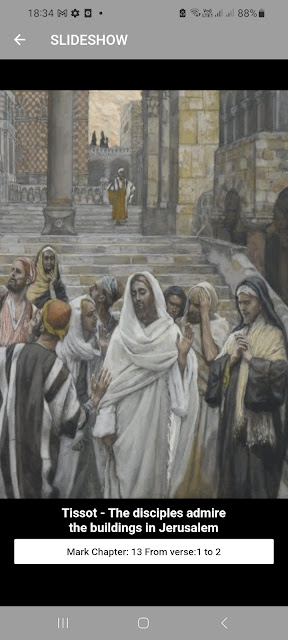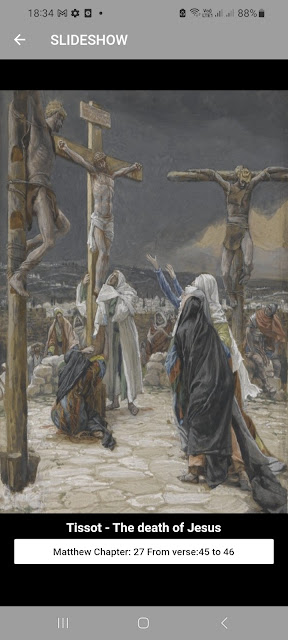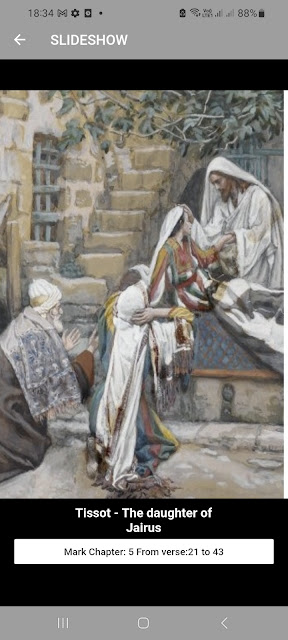We have about 1,000 works of art in our Jesus pictures wallpaper app, part of which you will find below:
a) Tissot The ear of Malthus John 18:10-11
In John 18:10-11, it is recorded that during Jesus' arrest in the Garden of Gethsemane, one of his disciples, Simon Peter, drew a sword and struck the high priest's servant, a man named Malchus, cutting off his right ear. Jesus rebuked Peter, telling him to put away his sword, and then healed Malchus, restoring the ear.
The healing is a demonstration of His compassion and power, even amid his own arrest and impending crucifixion. It also highlights the nonviolent nature of His mission, as he explicitly rejects the use of violence to defend himself or his cause.
b) Tissot The disciples baptize Matt 28:19
In Matthew 28:19, the Lord gives his disciples what is known as the Great Commission: "Go therefore and make disciples of all nations, baptizing them in the name of the Father and of the Son and of the Holy Spirit." This command is a call to evangelism, encouraging the disciples to spread the His message and make new converts among all people.
The act of baptizing new converts was a way for the disciples to symbolize their initiation into the community of believers and their commitment to following him.
c) The disciples admire the buildings in Jerusalem Mark 13:1-2
In Mark 13:1-2, it is recorded that as the Lord and his disciples were leaving the temple in Jerusalem, the disciples remarked on the impressive architecture and size of the buildings. Jesus responded by telling them that not one stone of the temple would be left upon another and that the temple would be destroyed.
His statement was a prophecy of the destruction of the temple which occurred in 70 AD when the Romans invaded and destroyed the city. This event had a profound impact on Judaism and early Christianity, as it was seen as a sign of God's judgment and a turning point in the history of the Jewish people.
d) Tissot The death of Christ Matt 27:45-46
In Matthew 27:45-46, it is recorded that as He hung on the cross, darkness fell over the land for three hours, from noon until three in the afternoon. At about the ninth hour, He cried out with a loud voice, "My God, my God, why have you forsaken me?" This cry is often referred to as the "cry of dereliction" and is one of the most poignant moments of His death.
The darkness that fell over the land is often interpreted as a sign of the significance of His death and as a symbol of the darkness and evil that his death would overcome. The cry of dereliction has been the subject of much debate and theological interpretation, with some seeing it as a moment of despair and abandonment, while others view it as a statement of faith and a recognition of the fulfilment of prophecy.
e) The daughter of Jairus
Jairus was a synagogue leader who sought the help of the Lord when his daughter became very ill and was near death. According to the Gospels, he pleaded with the Lord to come and heal his daughter, and He agreed to go with him. On the way, a large crowd followed, and a woman who had been suffering from a bleeding disorder for 12 years touched the hem of His cloak and was healed.
When they arrived at Jairus' house, they found that the little girl had already died. However, the Lord told Jairus not to be afraid and to have faith. He then went into the room where the girl lay and took her by the hand, saying "Talitha koum," which means "Little girl, I say to you, get up!" Miraculously, the girl came back to life and began to walk around.
This story is often interpreted as a demonstration of His power over death and his ability to heal those who are sick or suffering. It is also seen as an example of faith, as Jairus believed in the Lord's ability to heal his daughter and was rewarded with her miraculous recovery.
f) The crowning with Thorns Matt 27:27-29
After the Lord was arrested and brought before Pontius Pilate, the Roman governor of Judea, he was stripped of his clothes and soldiers led him away to be crucified. Before they took him away, however, they mocked him by placing a crown of thorns on his head and placing a reed in his right hand.
The soldiers then knelt before him and mocked him, saying "Hail, king of the Jews!" They spat on him and struck him on the head with the reed. The soldiers were mocking Jesus because he was being referred to as the Messiah, which the Roman authorities interpreted as King; a direct threat to Roman authority. To be fair to the Romans however, Pontius Pilate found Jesus to be without fault and were it not for the machinations of the Jewish leadership, Pilate would probably have let him go.
g) Tissot The calling of St James and John
According to the Gospels, James and John were fishermen who were working with their father Zebedee when the Lord approached them and asked them to follow him. Immediately, they left their fishing nets and their father and followed Him. In the Gospel of Mark the Lord said to them "Come, follow me, and I will make you fishers of men."
The calling of the brothers is seen as an example of how Christ called people from all walks of life. It also illustrates the idea that following Him requires a willingness to leave behind one's former life and embrace a new way of living.
James and John went on to become two of the Lords closest disciples and were present at many of the key moments in his life and ministry, including the Transfiguration and the Last Supper. They are often depicted in Christian art alongside the other apostles as important figures in the history of the Church.
Enjoy






